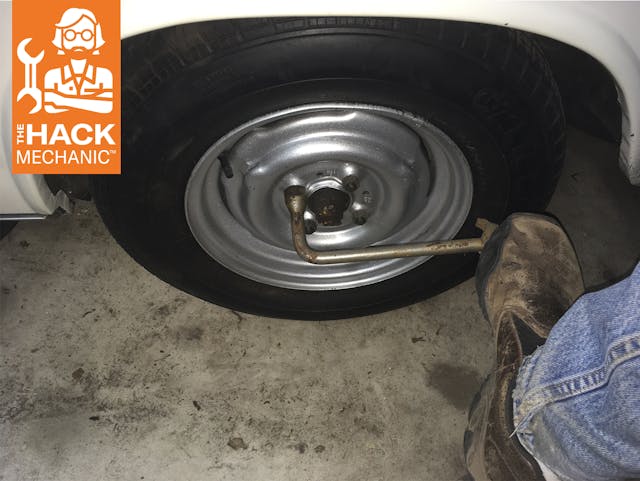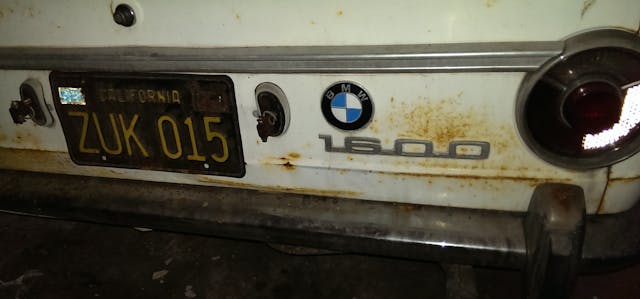That time my wheel fell off and rolled past me on the street

My wife has long hypothesized that a good part of my appeal as a writer is that, when it comes to doing the kind of stupid automotive things that most people keep locked away in a toolbox of shame—you know, things like leaving the drain pan full of oil under the car and then backing over it, or using a ratchet and socket to rotate the engine, leaving it on the crank nut, forgetting it’s there, then starting the engine and having it fly off and destroy something—I’m willing to take one for the team and embarrass myself publicly for a good laugh.
So, with that in mind, I’ll tell you a story.
It was December 1984, our first winter back in Boston after a 2½-year sojourn in Austin, Texas. When we moved home, we brought Bertha, the rust-free 1975 BMW 2002 I’d bought in Texas that past spring. BMW 2002s weren’t the collectibles they are now—Bertha was just another nine-year-old German car—but their propensity for rusting in snowy climates was already well known. I daily-drove Bertha, but I didn’t want the New England salt monster to destroy the car, so I looked for a winter beater, or as we say in Boston, a “wintah beatah.”
Being a diehard 2002 guy, it made sense to me to find—you guessed it—another 2002, something rusty and on its last legs, so I could limp it through the winter and then use it as an organ donor in the spring. I had a very short commute to work—only about five miles on local roads, no highway—so I figured that I could drive back and forth in just about anything. (This kicked off, by the way, a formula that has lasted to this day: Short commute means no need for a low-mileage hyper-reliable well-appointed car, which means … spend the money on fun cars.)
I found what seemed to fit the bill—a rusty, ratty BMW 1600, which is a 2002 with a smaller-displacement engine. It had been sitting in the backyard of a house a few miles from where I lived. It had no front bumper or grilles, but it wore an extra set of lights mounted in wooden blocks where the grilles used to be, making it look like someone tried to build one of those submarines on the inside back page of a comic book.
I put a charged battery in it, poured a few gallons of fresh gas in the tank, goosed it with starter fluid, got it running, paid the owner $75, rocked the stuck front calipers and rear drums free, and nursed it on dry-rotted tires back to my house. I did some light sorting out on it, and with the verve, enthusiasm, and naiveté of youth, began driving it to and from work while accumulating a punch list of winter needs.

I immediately discovered that the clutch slipped so badly that I had trouble making it up one hill between home and work. Granted, I lived in Brighton and worked in Newton, and that hill was “Heartbreak Hill” of Boston Marathon fame, but the hill really isn’t all that big; it climbs only 91 feet over 4/10 of a mile. Its heartbreak status is more due to the fact that it comes at the 20-mile point of the 26-mile marathon route. I found that, in order to get over the hill without seeing the tach zing up without accompanying forward thrust, I needed to put the car in third gear and just barely touch the gas. But no matter—the important part was that, with winter fast approaching, it looked like the car would serve its intended purpose as a “wintah beatah.”
I found a set of four used, studded snow tires on steel wheels. When the first snow began to fall, I swapped the wheels—to be clear, I was literally changing wheels by the curbside in the snow—then, to save time, threw the jack (one of those small floor jacks that fits in a plastic box) in the trunk instead of bringing it back into the garage, and beat it in to work. I made it without incident.
By the time I headed home that evening, several inches of snow had fallen. As I wended my way through Newton and back into Brighton, I was delighted by how sure-footed the little car felt on its four studded snows. Yeah, I thought, this is going to work out just great.
And then, from the back of the car, I began to hear a metallic whubba-whubba whubba. Anyone who’s ever had this happen knows it unfolds remarkably quickly; you may have less than 10 seconds between that first whubba-whubba and… BANG!
The car began skidding ignominiously on the bottom of the left rear brake drum. Obviously, I’d forgotten to tighten the lug nuts on that wheel during my hasty snow-decorated wheel swap. D’oh!
I tried, as much as anyone can concentrate during such an unanticipated event, to steer the car straight. However, I could not help but notice the absolutely surreal Wizard of Oz-like scene that was occurring out my driver’s door window, which was that I could see my wheel passing me.
Worse, I was now on the downslope of Heartbreak Hill through Boston College, and the renegade wheel began picking up speed. I watched with horror as its path hooked left, it hit a curb, bounced surprisingly high in the air, and headed straight for the front of a house.
So, here I was, on Commonwealth Avenue in Newton, which is not exactly a back road. I’d brought the ratty 1600 to a controlled stop as far over to the right as I could get it, but with it sitting on its left rear brake drum, the right front corner of the nose angled oddly in the air. It was as conspicuous as a beached whale.
And, oh, did I mention that, in my 26-year-old genius, I’d decided that the 1600 looked just like the 2002 so I didn’t need to insure or register it? I just swapped the plates. When I think about this now, even the obvious illegality and insurance risk ramifications notwithstanding, I think “Were you NUTS? The two cars looked NOTHING alike. One had big bumpers and square taillights, the other small bumpers and round taillights. One looked like an actual car, the other looked like a demented mechanical shark. THEY WEREN’T EVEN THE SAME COLOR!” Ah, the “logic” of youth.

I walked through the snow maybe 50 yards down the hill to where I thought I’d seen the wheel jump the curb, all the while turning around at regular intervals and expecting to see flashing blue lights pulling up behind my ludicrous and wounded vehicle, which looked so out of place in swank Newton that I imagined it would practically scream “lock up the idiot who owns this” to any police officer. My wonderful youthful legal logic tugged at me again, as I thought “Damn! I should’ve pulled the plates off it. That way, if the police show up it, I could simply walk away from it.” I sighed fatalistically, as that ship had sailed; I figured that the snowplows would come, they’d see the car, they’d radio the police, and I’d be screwed. Still, there seemed little to do but locate the wheel and try to put it back on.
It took a little searching, but I found the wheel. It was embedded in a hedge right against the front of a house, just two feet to the right of a big plate glass window. I could see people inside through the window, so I rang the bell and informed them that I was just retrieving a wheel that had fallen off my car and bounced into their hedge. No big deal. Nothing to be alarmed at. Carry on. (You ever have those moments where you hear yourself talk, it makes sense to you, but you know the person you’re talking to must think you’re a weapons-grade loon?)
I rolled the wheel back to the hobbled little 1600, marveled at the fact that the car wasn’t swarmed by police, and couldn’t believe my good luck that I’d thrown the jack in the trunk. Then I realized that it didn’t matter because I had no lug nuts; obviously if the wheel had fallen off, so had they. I hunted along the car’s skid path, and to my amazement, I found two of them on the street in the snow. I stomped the lug wrench down on them to get them nice and tight, and beat it back home, laughing at the downs and ups of my fortunes. (And, yes, after not getting caught by the teacher when I didn’t have my homework done, I did correctly register and insure the car.)
For years after that, I overcompensated on lug nut torque. For a BMW 2002, the spec is 59–64 ft-lbs. I began using the torque wrench at a setting closer to 70. But not long after, I invested in air tools and started locking down lug nuts with my then-new impact wrench. I first cycled through all the settings on the impact wrench and measured the resulting lug nut tightness with a torque wrench. I found that, if I squeezed the trigger and counted to two, setting 3 (of 5) produced 75–80 ft-lbs. I tightened lug nuts like this for decades. It was very quick and felt safe … until it nearly happened again, perhaps 25 years later, while driving a different 2002 to work.
I again heard that tell-tale metallic whubba-whubba-whubba, and this time I immediately stopped. Just in time, too—one of the rear wheels was about to fall off. I later discovered that my now-25-year-old impact wrench was dying, and that the “calibration” I thought I had on setting 3 wasn’t twisting the lug nuts nearly as tight as it used to. After that, I began doing what I should’ve done all along—assiduously using a torque wrench on lug nuts, and double-checking if there’s the slightest chance that I got interrupted.
Backing over the oil drain pan? Careless and messy, but little more. Leaving the wrench on the crank nut? Scratched paint and a dented radiator. But losing a wheel? Until the day I die, I’ll remember the sick feeling of trying to keep control of the car and seeing my own wheel pass me, and I’ll be able to point to the section of road the brake drum skidded on and to the window of the house the wheel nearly crashed through.
Yeah. Use a torque wrench.
***
Rob Siegel has been writing a column (The Hack Mechanic™) for BMW CCA Roundel magazine for 34 years and is the author of seven automotive books. His new book, The Lotus Chronicles: One man’s sordid tale of passion and madness resurrecting a 40-year-dead Lotus Europa Twin Cam Special, is now available on Amazon (as are his other books), or you can order personally-inscribed copies from Rob’s website, robsiegel.com.

